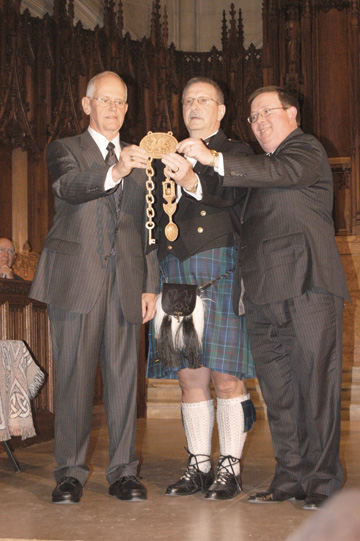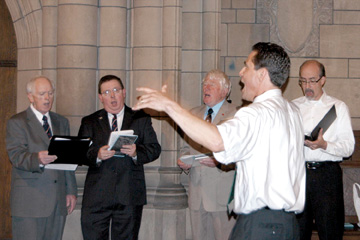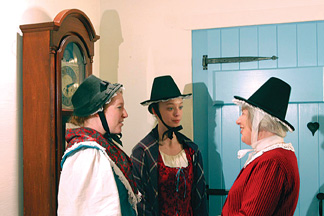Pitt’s Welsh Nationality Room Opened June 1 With Grand Celebration
The room is the 27th in Pitt’s collection of ethnic classrooms

G. Reynolds Clark, Pitt vice chancellor for community initiatives and chief of staff, Office of the Chancellor, accepts the Ceremonial Key to the newly dedicated Welsh Nationality Room from Dale Richards and John R. Owen, III, cochairs of the Welsh Nationality Room Committee. The key incorporates many symbols from Wales in its enlarged lovespoon.
The University of Pittsburgh Nationality Rooms Program has added another gem to its stunning collection of ethnic classrooms in the Cathedral of Learning, 4200 Fifth Ave., Oakland. The Welsh Nationality Room, the 27th of the group, was opened with a private blessing ceremony followed by the formal dedication at 3 p.m. June 1 in Heinz Memorial Chapel, Fifth and Bellefield avenues.
After the dedication, invited guests attended a reception in the Cathedral of Learning’s Commons Room and toured the newly dedicated room, Room 342 on the Cathedral’s third floor. During the reception, Welsh tenor Kenneth Davies and a Welsh chorus performed Welsh classical and folk music.
Patterned after the Pen-rhiw Chapel, an 18th-century Non-Conformist chapel at St. Fagans National History Museum near Cardiff, Wales, the Welsh Nationality Room represents a converted Welsh barn. It is a simple Non-Conformist chapel (capel) with a connected pastor’s dwelling, or ty capel, at the entrance.
The University requires that all Nationality Room designs precede 1787, the founding date of the University.
The Welsh Nationality Room Committee comprises members of Pittsburgh’s St. David’s Society, which had proposed the idea for a Welsh Nationality Room to E. Maxine Bruhns, director of the Nationality Rooms and Intercultural Exchange Programs; in 2001, the University and the society approved the project. Architects Martin Powell and Katherine Horstman from The Design Alliance were chosen to design the classroom.
Working with Bruhns, the Welsh Room’s concept committee studied such designs as those for a manor house, castle, and farmhouse. The group settled on the chapel design because of a chapel’s importance to community life in rural 18th-century Wales. In addition to being a place of worship, chapels were the centers of village social life. They also were the place where children and adults learned to read and write the Welsh language.
In Wales, the ability to worship and hear a sermon in Welsh was more important to members of the congregation than the style of the building and the furniture. Simplicity was the fashion, and a chapel might once have been a barn.
The Welsh Room includes poplar beams and walls covered with milk paint. The door replicates a barn door with wrought iron hinges. Artifacts are displayed in a case just inside the door, including a Welsh hymnal, pottery, kitchen equipment, and a metal plaque inscribed in Welsh. Opposite the door is an oak longcase clock, which was one of the most important furnishings in a Welsh home. The Welsh Room clock sits on a platform faced in slate. For many years, fine-quality slate was a principal export of North Wales.
The room’s furnishings include a raised pulpit made of white pine with a deacon’s bench on either side. The professor’s table, or communion table, stands at the end of the room. Box pews and long benches provide student seating.
The Welsh Nationality Room Committee is the first to raise funds to design, construct, and dedicate its classroom in seven years, and the Welsh Nationality Room is the second to be dedicated in the new millennium.

Members of the Welsh Nationality Room Committee join in singing with Welsh chorus.

Members of Quo Vadis, Nationality Rooms tour guides, share conversation in the new room.
Other Stories From This Issue
On the Freedom Road

Follow a group of Pitt students on the Returning to the Roots of Civil Rights bus tour, a nine-day, 2,300-mile journey crisscrossing five states.
Day 1: The Awakening
Day 2: Deep Impressions
Day 3: Music, Montgomery, and More
Day 4: Looking Back, Looking Forward
Day 5: Learning to Remember
Day 6: The Mountaintop
Day 7: Slavery and Beyond
Day 8: Lessons to Bring Home
Day 9: Final Lessons

